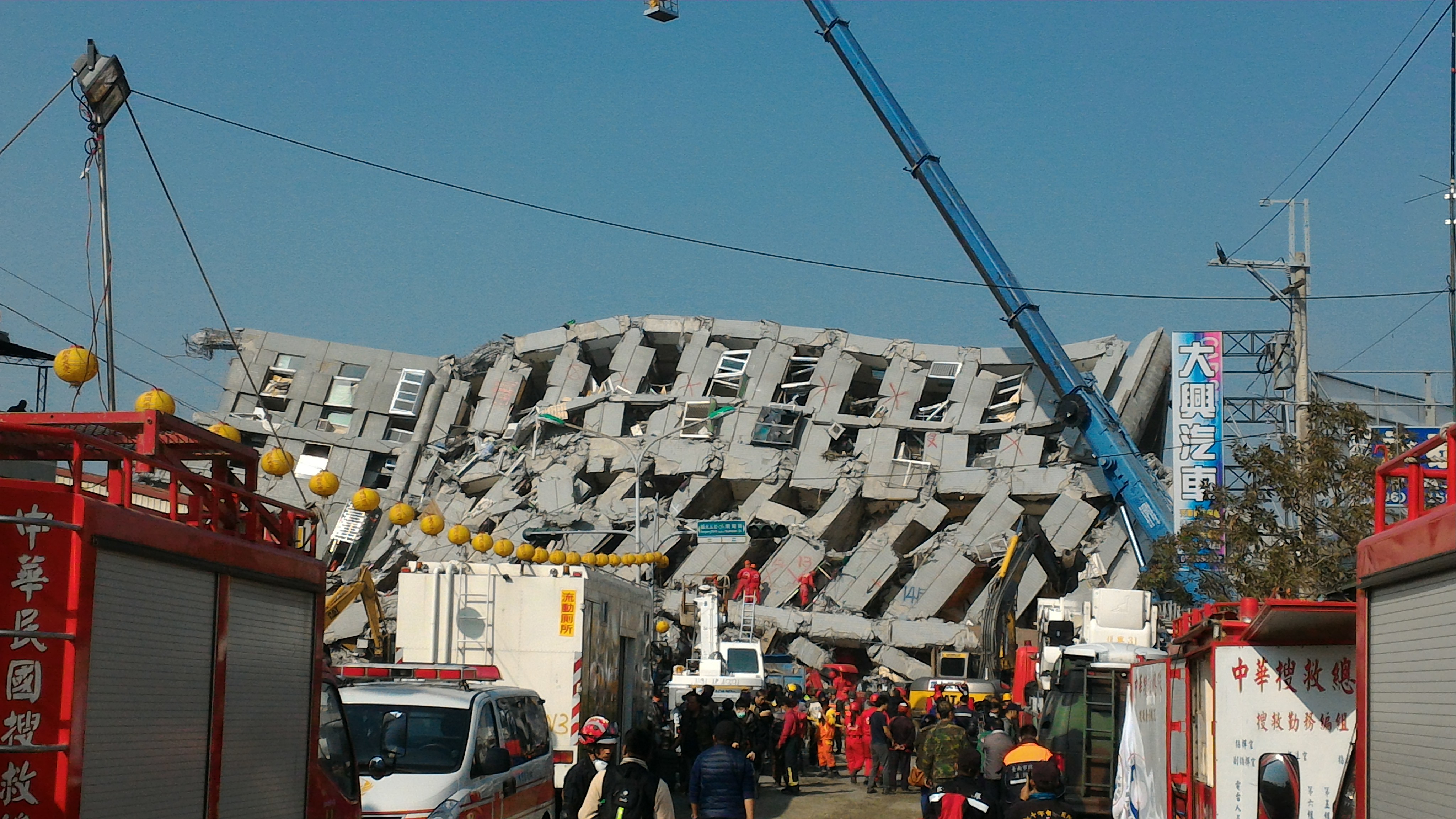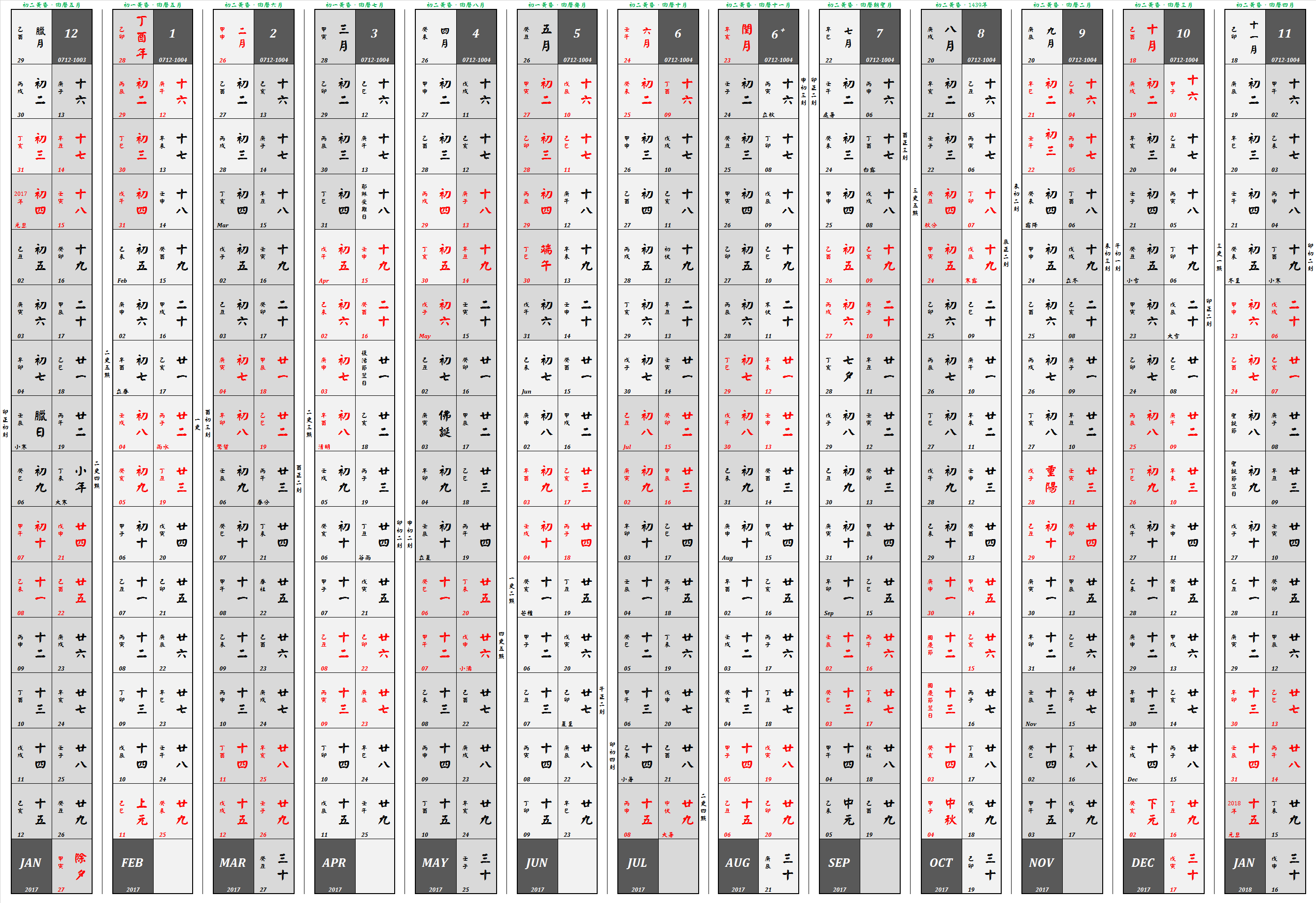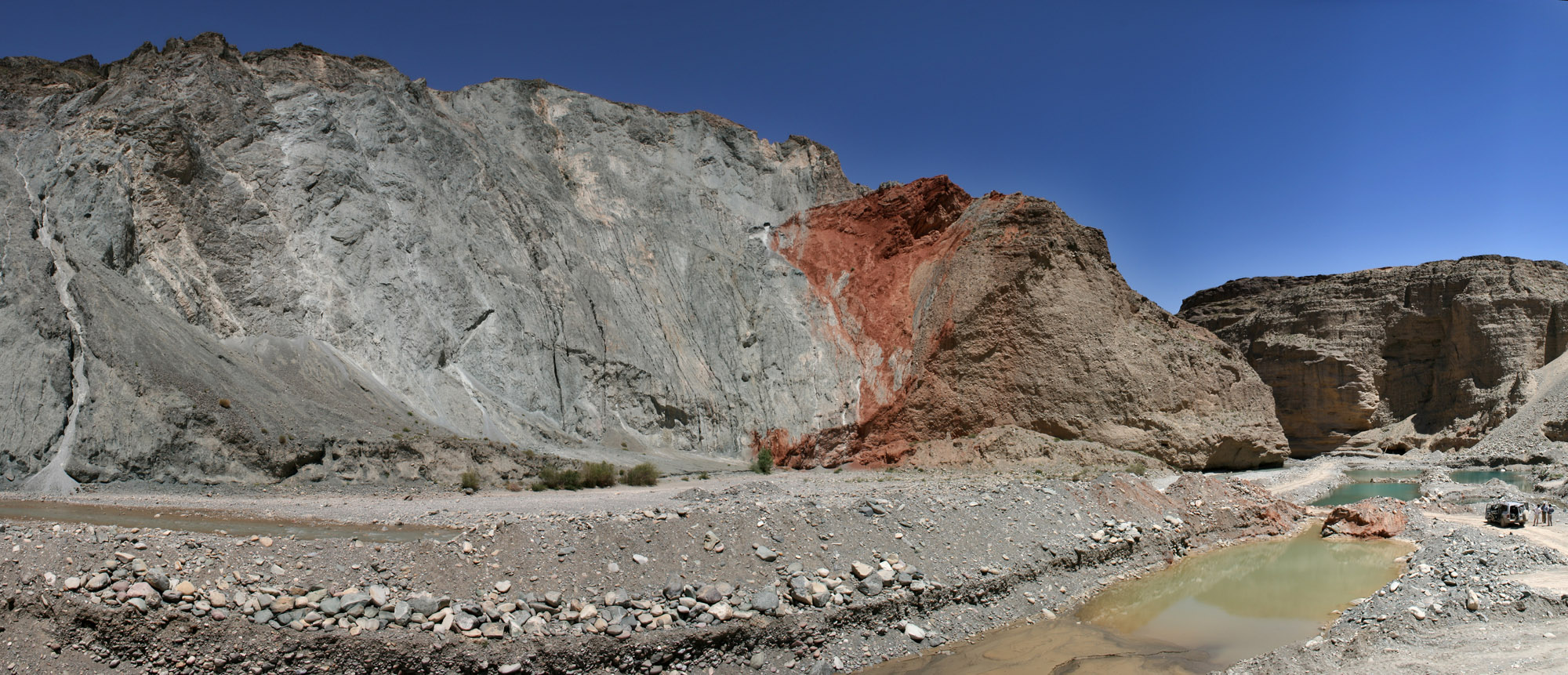|
2016 Kaohsiung Earthquake
At 03:57 local time on 6 February 2016, an earthquake with a moment magnitude of 6.4 struck 28 km (17 mi) northeast of Pingtung City in southern Taiwan, in the Meinong District of Kaohsiung. The earthquake struck at a depth of around 23 km (14 mi). Its comparatively shallow depth caused more intense reverberations on the surface. The earthquake had a maximum intensity of VII (''Very strong'') on the Mercalli intensity scale, causing widespread damage and 116 deaths. Almost all of the deaths were caused by a collapsed residential building, named Weiguan Jinlong in Yongkang District, while two other people were killed in Gueiren District. Sixty-eight aftershocks have occurred. The earthquake was the deadliest earthquake in Taiwan since the 1999 Jiji earthquake. Geology Taiwan is located on the Ring of Fire, making it prone to intense earthquakes. However, the February 2016 event was particularly destructive and deadly. Taiwan lies on the boundary between th ... [...More Info...] [...Related Items...] OR: [Wikipedia] [Google] [Baidu] |
Peak Ground Acceleration
Peak ground acceleration (PGA) is equal to the maximum ground acceleration that occurred during earthquake shaking at a location. PGA is equal to the amplitude of the largest absolute acceleration recorded on an wikt:accelerogram, accelerogram at a site during a particular earthquake. Earthquake shaking generally occurs in all three directions. Therefore, PGA is often split into the horizontal and vertical components. Horizontal PGAs are generally larger than those in the vertical direction but this is not always true, especially close to large earthquakes. PGA is an important parameter (also known as an intensity measure) for earthquake engineering, The design basis earthquake ground motion (DBEGM) is often defined in terms of PGA. Unlike the Richter magnitude scale, Richter and Moment magnitude scale, moment magnitude scales, it is not a measure of the total seismic scales#Magnitude and intensity, energy (magnitude, or size) of an earthquake, but rather of how hard the earth shake ... [...More Info...] [...Related Items...] OR: [Wikipedia] [Google] [Baidu] |
Philippine Sea Plate
The Philippine Sea Plate or the Philippine Plate is a tectonic plate comprising oceanic lithosphere that lies beneath the Philippine Sea, to the east of the Philippines. Most segments of the Philippines, including northern Luzon, are part of the Philippine Mobile Belt, which is geologically and tectonically separate from the Philippine Sea Plate. The plate is bordered mostly by convergent boundaries:Smoczyk, G.M., Hayes, G.P., Hamburger, M.W., Benz, H.M., Villaseñor, Antonio, and Furlong, K.P., 2013Seismicity of the Earth 1900–2012 Philippine Sea Plate and vicinity U.S. Geological Survey Open-File Report 2010–1083-M, scale 1:10,000,000, ''https://dx.doi.org/10.3133/ofr20101083m''. To the north, the Philippine Sea Plate meets the Okhotsk Plate at the Nankai Trough. The Philippine Sea Plate, the Amurian Plate, and the Okhotsk Plate meet near Mount Fuji in Japan. The thickened crust of the Izu–Bonin–Mariana arc colliding with Japan constitutes the Izu Collision Zone. The ... [...More Info...] [...Related Items...] OR: [Wikipedia] [Google] [Baidu] |
Chinese Calendar
The traditional Chinese calendar (also known as the Agricultural Calendar ��曆; 农历; ''Nónglì''; 'farming calendar' Former Calendar ��曆; 旧历; ''Jiùlì'' Traditional Calendar ��曆; 老历; ''Lǎolì'', is a lunisolar calendar which identifies years, months, and days according to astronomical phenomena. In China, it is defined by the Chinese national standard GB/T 33661–2017, "Calculation and Promulgation of the Chinese Calendar", issued by the Standardization Administration of China on May 12, 2017. Although modern-day China uses the Gregorian calendar, the traditional Chinese calendar governs holidays, such as the Chinese New Year and Lantern Festival, in both China and overseas Chinese communities. It also provides the traditional Chinese nomenclature of dates within a year which people use to select auspicious days for weddings, funerals, moving or starting a business. The evening state-run news program ''Xinwen Lianbo'' in the P.R.C. continues to anno ... [...More Info...] [...Related Items...] OR: [Wikipedia] [Google] [Baidu] |
Infant
An infant or baby is the very young offspring of human beings. ''Infant'' (from the Latin word ''infans'', meaning 'unable to speak' or 'speechless') is a formal or specialised synonym for the common term ''baby''. The terms may also be used to refer to juveniles of other organisms. A newborn is, in colloquial use, an infant who is only hours, days, or up to one month old. In medical contexts, a newborn or neonate (from Latin, ''neonatus'', newborn) is an infant in the first 28 days after birth; the term applies to premature, full term, and postmature infants. Before birth, the offspring is called a fetus. The term ''infant'' is typically applied to very young children under one year of age; however, definitions may vary and may include children up to two years of age. When a human child learns to walk, they are called a toddler instead. Other uses In British English, an ''infant school'' is for children aged between four and seven. As a legal term, ''infancy'' is more lik ... [...More Info...] [...Related Items...] OR: [Wikipedia] [Google] [Baidu] |
Weiguan Jinlong Building
At 03:57 local time on 6 February 2016, an earthquake with a moment magnitude of 6.4 struck 28 km (17 mi) northeast of Pingtung City in southern Taiwan, in the Meinong District of Kaohsiung. The earthquake struck at a depth of around 23 km (14 mi). Its comparatively shallow depth caused more intense reverberations on the surface. The earthquake had a maximum intensity of VII (''Very strong'') on the Mercalli intensity scale, causing widespread damage and 116 deaths. Almost all of the deaths were caused by a collapsed residential building, named Weiguan Jinlong in Yongkang District, while two other people were killed in Gueiren District. Sixty-eight aftershocks have occurred. The earthquake was the deadliest earthquake in Taiwan since the 1999 Jiji earthquake. Geology Taiwan is located on the Ring of Fire, making it prone to intense earthquakes. However, the February 2016 event was particularly destructive and deadly. Taiwan lies on the boundary between the Eu ... [...More Info...] [...Related Items...] OR: [Wikipedia] [Google] [Baidu] |
Tainan
Tainan (), officially Tainan City, is a Special municipality (Taiwan), special municipality in southern Taiwan facing the Taiwan Strait on its western coast. Tainan is the oldest city on the island and also commonly known as the "Capital City" for its over 200 years of history as the capital of Taiwan under Koxinga and later Qing rule. Tainan's complex history of comebacks, redefinitions and renewals inspired its popular nickname "the Phoenix City". Tainan is classified as a "Sufficiency" level global city by the Globalization and World Cities Research Network. As Taiwan's oldest urban area, Tainan was initially established by the Dutch East India Company (VOC) as a ruling and trading base called Fort Zeelandia (Taiwan), Fort Zeelandia during Dutch Formosa, the period of Dutch rule on the island. After Dutch colonists were defeated by Koxinga in 1661, Tainan remained as the capital of the Kingdom of Tungning, Tungning Kingdom until 1683 and afterwards the capital of Taiwan Pref ... [...More Info...] [...Related Items...] OR: [Wikipedia] [Google] [Baidu] |
Ground Motion
Ground motion is the movement of the earth's surface from earthquakes or explosions. Ground motion is produced by seismic waves that are generated by sudden slip on a fault or sudden pressure at the explosive source and travel through the earth and along its surface. This can be due to natural events, such as earthquakes and volcanic eruptions, or human activities, such as the detonation of nuclear weapons. There are two main types of seismic waves: body waves and surface waves. Body waves travel through the interior of the earth, while surface waves travel along the earth's surface. Ground motion is typically caused by surface waves, which are the most destructive type of seismic waves. Ground motion is measured using a seismometer, a device that detects and records the movement of the earth's surface. Seismometers are used by seismologists to study earthquakes and other types of ground motion. The recordings produced by a seismometer are known as seismograms, and they can be use ... [...More Info...] [...Related Items...] OR: [Wikipedia] [Google] [Baidu] |
Chianan Plain
Chianan or Jianan may refer to: Taiwan * Chianan Plain, largest plain in Taiwan * Chianan Irrigation, canals of Chianan Plain of Taiwan Han Dynasty *Jian'an, name for the period of rule (196—220) of the Emperor Xian of Han *Seven Scholars of Jian'an, group of scholars from the above period *Jian'an poetry, Chinese poetry style associated with the late Han Dynasty Others *Jian'an Subdistrict, Shijiazhuang Jian'an Subdistrict () is a subdistrict of Qiaodong District, Shijiazhuang, Hebei Hebei or , (; alternately Hopeh) is a northern province of China. Hebei is China's sixth most populous province, with over 75 million people. Shijiaz ..., subdistrict of Qiaodong District * Wang Jianan (athlete) (born 1996), Chinese male long jumper {{geodis ... [...More Info...] [...Related Items...] OR: [Wikipedia] [Google] [Baidu] |
Tainan City
Tainan (), officially Tainan City, is a special municipality in southern Taiwan facing the Taiwan Strait on its western coast. Tainan is the oldest city on the island and also commonly known as the "Capital City" for its over 200 years of history as the capital of Taiwan under Koxinga and later Qing rule. Tainan's complex history of comebacks, redefinitions and renewals inspired its popular nickname "the Phoenix City". Tainan is classified as a "Sufficiency" level global city by the Globalization and World Cities Research Network. As Taiwan's oldest urban area, Tainan was initially established by the Dutch East India Company (VOC) as a ruling and trading base called Fort Zeelandia during the period of Dutch rule on the island. After Dutch colonists were defeated by Koxinga in 1661, Tainan remained as the capital of the Tungning Kingdom until 1683 and afterwards the capital of Taiwan Prefecture under Qing Dynasty rule until 1887, when the new provincial capital was first mo ... [...More Info...] [...Related Items...] OR: [Wikipedia] [Google] [Baidu] |
Crust (geology)
In geology, the crust is the outermost solid shell of a rocky planet, dwarf planet, or natural satellite. It is usually distinguished from the underlying mantle by its chemical makeup; however, in the case of icy satellites, it may be distinguished based on its phase (solid crust vs. liquid mantle). The crusts of Earth, Mercury, Venus, Mars, Io, the Moon and other planetary bodies formed via igneous processes and were later modified by erosion, impact cratering, volcanism, and sedimentation. Most terrestrial planets have fairly uniform crusts. Earth, however, has two distinct types: continental crust and oceanic crust. These two types have different chemical compositions and physical properties and were formed by different geological processes. Types of crust Planetary geologists divide crust into three categories based on how and when it formed. Primary crust / primordial crust This is a planet's "original" crust. It forms from solidification of a magma ocean. Towa ... [...More Info...] [...Related Items...] OR: [Wikipedia] [Google] [Baidu] |
Thrust Fault
A thrust fault is a break in the Earth's crust, across which older rocks are pushed above younger rocks. Thrust geometry and nomenclature Reverse faults A thrust fault is a type of reverse fault that has a dip of 45 degrees or less. If the angle of the fault plane is lower (often less than 15 degrees from the horizontal) and the displacement of the overlying block is large (often in the kilometer range) the fault is called an ''overthrust'' or ''overthrust fault''. Erosion can remove part of the overlying block, creating a ''fenster'' (or ''window'') – when the underlying block is exposed only in a relatively small area. When erosion removes most of the overlying block, leaving island-like remnants resting on the lower block, the remnants are called ''klippen'' (singular ''klippe''). Blind thrust faults If the fault plane terminates before it reaches the Earth's surface, it is referred to as a ''blind thrust'' fault. Because of the lack of surface evidence, blind thr ... [...More Info...] [...Related Items...] OR: [Wikipedia] [Google] [Baidu] |

.jpg)






